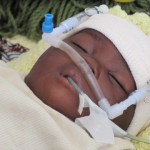 Students from Rice University in Houston, Texas, have designed a very low cost CPAP machine using aquarium pumps. Their device has increased the survival rate of infants with respiratory distress from 44% to 71% in Malawi, the country with the highest premature birth rate in the world, according to the World Health Organization.
Students from Rice University in Houston, Texas, have designed a very low cost CPAP machine using aquarium pumps. Their device has increased the survival rate of infants with respiratory distress from 44% to 71% in Malawi, the country with the highest premature birth rate in the world, according to the World Health Organization.
A typical Continuous Positive Airway Pressure (CPAP) machine can cost more than $6,000. The Rice students’ machine can be manufactured for about $350, which is a tremendous benefit for hospitals in poor countries.
In Malawi, when a newborn is having trouble breathing, extra oxygen tubes are placed in the baby’s nose. But no air pressure is added to help inflate the infant’s lungs. All countries treated respiratory distress this way until the CPAP was invented in the 1970’s. With a CPAP machine, gentle air pressure is pushed through the tubes into the nostrils and/or mouth to help facilitate breathing.
Doctors know it takes very little air pressure to help newborns breathe. The Rice students found that two aquarium pumps provided the perfect amount of pressure for tiny lungs. Their machine is also easily portable. The original prototype was housed in a shoebox.
So far the aquarium pump CPAPs have been introduced in nine government hospitals in Malawi and plans are underway to expand into private hospitals and other countries.
Read more.
